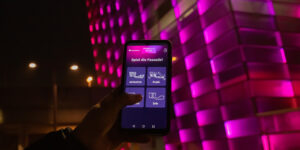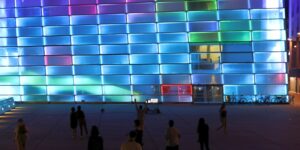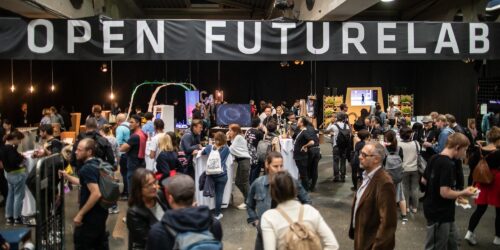Peter Holzkorn
-

Data Art & Science Project
Art Creates Meaning from Data
How can art create meaning from data? The Ars Electronica Futurelab, in collaboration with Toyota Coniq in Japan, is envisioning “Data Art & Science,” a new interdisciplinary field that incorporates artistic perspectives on future transformations based on data science.
-

Glockner.Luft.Raum
Climate and Weather Data Experience
Glockner.Luft.Raum is an approximately 15-minute data-based generative sequence that makes the complex connections between global climate change and regional weather kitchen in the Austrian Glockner region visible, audible, and tangible.
-

Play the Façade
38,500 LEDs to Spark Public Creativity
The façade of the Ars Electronica Center, with its 38,500 LEDs, has been shaping the cityscape of Linz since 2009. Just one year later, the public was able to take control of the illuminated museum exterior for the first time via the façade terminal. This was followed in 2022 by the new edition – with…
-

Northeastern University 2022
Ars Electronica Futurelab Academy
In July 2022, students from Northeastern University (Boston, USA) joined the Futurelab for the second time for a three-day interactive art workshop. It focused on creating experiences for the Ars Electronica media facade – the glowing, colorful centerpiece of the city and second skin of the Ars Electronica Center.
-

Stream of Hope
Large-Scale Fluxel Performance in Japan
Ars Electronica Futurelab’s Fluxels, a scalable swarm of ground robots equipped with hexagonal LED displays, brought about a new language of visual expression. Stream of Hope in Osaka and Yokohama showcased their versatility at large-scale events.
-

Space Ink
Three-Dimensional Drawings With Drones
What if we can draw in any space with a pen? This question is at the heart of Space Ink, where tablets and drones are brought together to create large-scale works in three-dimensional space using light and color.
-

Future Ink
In Creativity, Where Is My Soul?
The Future Ink Project is a research project to explore the future of creativity from all aspects of ink. Various prototypes were developed in the course of Future Ink, from using tablets and drones to paint to visualizing brainwaves and body signals as immersive three-dimensional ink.
-

CoBot Studio
As humans and robots work together ever more closely, their joint success is linked to certain preconditions: How do you create safe working environments? How can we increase the acceptance of robots in everyday work? And how do you communicate with a colleague who consists only of a gripper arm?
-

Open Futurelab 2019
The festival site at POSTCITY in Linz was used as a stage for Open Futurelab until 2019. Created with the Japanese public broadcasting company NHK, Media Platz was a prototype of an open media plaza consisting of cardboard and high-resolution screens, which was used as a forum for public debate. Various panel discussions took place…


